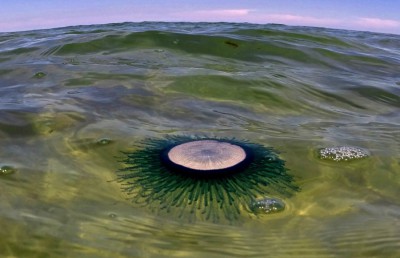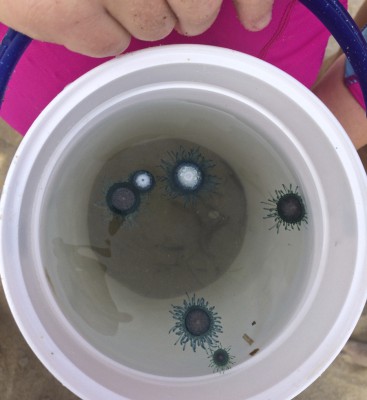Reprinted from the Outer Banks Voice
KILL DEVIL HILLS — High pressure sitting on top of the Outer Banks for much of the summer may be why a peculiar and eye-catching ocean dweller has made an appearance along the shores of area beaches.
Supporter Spotlight

Blue buttons, or porpita porpita, have been seen drifting in the surf zone and washing up, attracting the attention of beachgoers because of their bright color and unique shape.
Brian Dorn, director of operations and husbandry at the N.C. Aquarium on Roanoke Island, said blue buttons are actually not jellyfish but a colony of hydroids that are most closely related to the Portuguese man o’ war.
Blue buttons are usually found offshore in tropical waters of the Atlantic Ocean and while it’s not unheard of, they are not regular visitors to Outer Banks waters.
About an inch in diameter, blue buttons have two parts — the float in the center, which is a small round disk with a mouth underneath, and the blue and purple hydroids, which have small stinging cells along them.
The stinging cells are used to catch food, but don’t deliver a sting that can be felt by people who may come in contact with them, Dorn said. They may cause some skin irritation, however.
Supporter Spotlight

The weather the Outer Banks has experienced this summer coupled with the infrequent northeasterly winds, Gulf Stream waters are nearly upon us and occasionally bring with them unusual dwellers like blue buttons, said David Elder, director of Kill Devil Hills’ Ocean Rescue.
“They’re normally offshore but occasionally the ocean will show us stuff like this and we have a chance to learn more,” he noted. “They’re not uncommon, but they are uncommon to our beach patrons. They’re neat to see.”
Dorn said blue buttons can survive in a lot of different areas and are usually found where two currents are converging. Like jellyfish, blue buttons are propelled by the wind and ocean currents.
Chad Motz, director of Nags Head’s Ocean Rescue, said there were a good number of blue buttons washing up on Nags Head beaches as well. He said the brightly-colored creatures are not a common sight on his beaches, either.
Blue buttons have also been spotted on Bogue Banks beaches in Carteret County.








